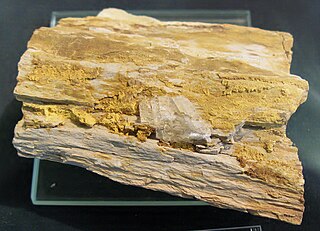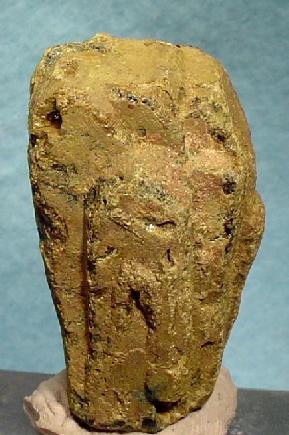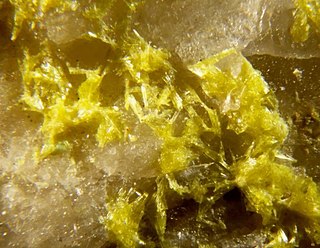
Thorium is a weakly radioactive metallic chemical element with the symbol Th and atomic number 90. Thorium is silvery and tarnishes black when it is exposed to air, forming thorium dioxide; it is moderately soft and malleable and has a high melting point. Thorium is an electropositive actinide whose chemistry is dominated by the +4 oxidation state; it is quite reactive and can ignite in air when finely divided.

Uraninite, formerly pitchblende, is a radioactive, uranium-rich mineral and ore with a chemical composition that is largely UO2 but because of oxidation typically contains variable proportions of U3O8. Radioactive decay of the uranium causes the mineral to contain oxides of lead and trace amounts of helium. It may also contain thorium and rare-earth elements.

Columbite, also called niobite, niobite-tantalite and columbate [(Fe, Mn)Nb
2O
6], is a black mineral group that is an ore of niobium. It has a submetallic luster and a high density and is a niobate of iron and manganese. This mineral group was first found in Haddam, Connecticut, in the United States. It forms a series with the tantalum-dominant analogue ferrotantalite and one with the manganese-dominant analogue manganocolumbite. The iron-rich member of the columbite group is ferrocolumbite. Some tin and tungsten may be present in the mineral. Yttrocolumbite is the yttrium-rich columbite with the formula (Y,U,Fe)(Nb,Ta)O
4. It is a radioactive mineral found in Mozambique.

Euxenite, or euxenite-(Y), is a brownish black mineral with a metallic luster.

Gadolinite, sometimes known as ytterbite, is a silicate mineral consisting principally of the silicates of cerium, lanthanum, neodymium, yttrium, beryllium, and iron with the formula (Ce,La,Nd,Y)2FeBe2Si2O10. It is called gadolinite-(Ce) or gadolinite-(Y), depending on the prominent composing element. It may contain 35.5% yttria sub-group rare earths, 2.2% ceria earths, as much as to 11.6% BeO, and traces of thorium. It is found in Sweden, Norway, and the US.

Carnotite is a potassium uranium vanadate radioactive mineral with chemical formula K2(UO2)2(VO4)2·3H2O. The water content can vary and small amounts of calcium, barium, magnesium, iron, and sodium are often present.

Thorite, (Th,U)SiO4, is a rare nesosilicate of thorium that crystallizes in the tetragonal system and is isomorphous with zircon and hafnon. It is the most common mineral of thorium and is nearly always strongly radioactive. It was named in 1829 to reflect its thorium content. Thorite was discovered in 1828 on the island of Løvøya, Norway, by the vicar and mineralogist, Hans Morten Thrane Esmark, who sent the first specimens of this black mineral to his father, Jens Esmark, who was a professor of mineralogy and geology.

Xenotime is a rare-earth phosphate mineral, the major component of which is yttrium orthophosphate (YPO4). It forms a solid solution series with chernovite-(Y) (YAsO4) and therefore may contain trace impurities of arsenic, as well as silicon dioxide and calcium. The rare-earth elements dysprosium, erbium, terbium and ytterbium, as well as metal elements such as thorium and uranium (all replacing yttrium) are the expressive secondary components of xenotime. Due to uranium and thorium impurities, some xenotime specimens may be weakly to strongly radioactive. Lithiophyllite, monazite and purpurite are sometimes grouped with xenotime in the informal "anhydrous phosphates" group. Xenotime is used chiefly as a source of yttrium and heavy lanthanide metals (dysprosium, ytterbium, erbium and gadolinium). Occasionally, gemstones are also cut from the finest xenotime crystals.

Thorianite is a rare thorium oxide mineral, ThO2. It was originally described by Ananda Coomaraswamy in 1904 as uraninite, but recognized as a new species by Wyndham R. Dunstan. It was so named by Dunstan on account of its high percentage of thorium; it also contains the oxides of uranium, lanthanum, cerium, praseodymium and neodymium. Helium is present, and the mineral is slightly less radioactive than pitchblende, but is harder to shield due to its high energy gamma rays. It is common in the alluvial gem-gravels of Sri Lanka, where it occurs mostly as water worn, small, heavy, black, cubic crystals. The largest crystals are usually near 1.5 cm. Larger crystals, up to 6 cm (2.4 in), have been reported from Madagascar.

Aeschynite-(Y) is a rare earth mineral of yttrium, calcium, iron, thorium, titanium, niobium, oxygen, and hydrogen with the chemical formula (Y,Ca,Fe,Th)(Ti,Nb)2(O,OH)6. Its name comes from the Greek word for "shame". Its Mohs scale rating is 5 to 6.

Steacyite is a complex silicate mineral containing thorium and uranium; formula Kvariable(Ca,Na)2(Th,U)Si8O20. It forms small brown or yellow green crystals, often cruciform twinned crystals. It is radioactive. It was discovered at Mont-Saint-Hilaire, Quebec in 1982 and is named after Harold Robert Steacy (1923–2012), mineralogist.

Yttrialite or Yttrialite-(Y) is a rare yttrium thorium sorosilicate mineral with formula: (Y,Th)2Si2O7. It forms green to orange yellow masses with conchoidal fracture. It crystallizes in the monoclinic-prismatic crystal system. It has a Mohs hardness of 5 to 5.5 and a specific gravity of 4.58. It is highly radioactive due to the thorium content.

Environmental radioactivity is not limited to actinides; non-actinides such as radon and radium are of note. While all actinides are radioactive, there are a lot of actinides or actinide-relating minerals in the Earth's crust such as uranium and thorium. These minerals are helpful in many ways, such as carbon-dating, most detectors, X-rays, and more.

Betafite is a mineral group in the pyrochlore supergroup, with the chemical formula (Ca,U)2(Ti,Nb,Ta)2O6(OH). Betafite typically occurs as a primary mineral in granite pegmatites, rarely in carbonatites. Originally defined by the B-site atom Ti, the development of new nomenclature for mineral names led to modernization of the system for nomenclature of pyrochlore and betafite in order to further rationalize the naming process of this grouping of minerals. Only two of the mineral species that were formerly recognized as betafite are presently retained. They are oxyuranobetafite and oxycalciobetafite. The term betafite is now a synonym or varietal group name under the pyrochlore super group.

Althupite (IMA symbol: Ahp) is a rare aluminium thorium uranyl phosphate mineral with complex formula written as AlTh(UO2)7(PO4)4O2(OH)5·15H2O, from a granitic pegmatite. It is named after its composition (ALuminium, THorium, Uranium, and Phosphorus).

Francevillite is a uranyl-group vanadate mineral in the tyuyamunite series. Its chemical formula is (Ba,Pb)(UO2)2V2O8·5(H2O). Francevillite is a strongly radioactive mineral. It is typically orange, yellow or brownish yellow. It forms a series with curienite.
Paulscherrerite, UO2(OH)2, is a newly named mineral of the schoepite subgroup of hexavalent uranium hydrate/hydroxides. It is monoclinic, but no space group has been determined because no single-crystal study has been done. Paulscherrerite occurs as a canary yellow microcrystalline powdery product with a length of ~500 nm. It forms by the weathering and ultimate pseudomorphism of uranium-lead bearing minerals such as metaschoepite. The type locality for paulscherrerite is the Number 2 Workings, Radium Ridge near Mount Painter, North Flinders Ranges, South Australia, an area where radiogenic heat has driven hydrothermal activity for millions of years. It is named for Swiss physicist Paul Scherrer, co-inventor of the Debye-Scherrer X-ray powder diffraction camera. Study of paulscherrerite and related minerals is important for understanding the mobility of uranium around mining sites, as well as designing successful strategies for the storage of nuclear weapons and the containment of nuclear waste.

Thorium-based nuclear power generation is fueled primarily by the nuclear fission of the isotope uranium-233 produced from the fertile element thorium. A thorium fuel cycle can offer several potential advantages over a uranium fuel cycle—including the much greater abundance of thorium found on Earth, superior physical and nuclear fuel properties, and reduced nuclear waste production. One advantage of thorium fuel is its low weaponization potential; it is difficult to weaponize the uranium-233/232 and plutonium-238 isotopes that are largely consumed in thorium reactors.
Grayite, ThPO4·(H2O), is a thorium phosphate mineral of the Rabdophane group first discovered in 1957 by S.H.U. Bowie in Rhodesia. It is of moderate hardness occurring occasionally in aggregates of hexagonal crystals occasionally but more commonly in microgranular/cryptocrystalline masses. Due to its thorium content, grayite displays some radioactivity although it is only moderate and the mineral displays powder XRD peaks without any metamict-like effects. The color of grayite is most commonly observed as a light to dark reddish brown but has also been observed as lighter yellows with grayish tints. It has a low to moderate hardness with a Mohs hardness of 3–4 and has a specific gravity of 3.7–4.3. It has been found in both intrusive igneous and sedimentary environments.

Davemaoite is a high-pressure calcium silicate perovskite mineral with a distinctive cubic crystal structure. It is named after geophysicist Ho-kwang (Dave) Mao, who pioneered in many discoveries in high-pressure geochemistry and geophysics.

















